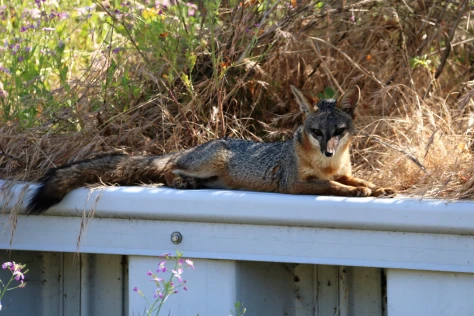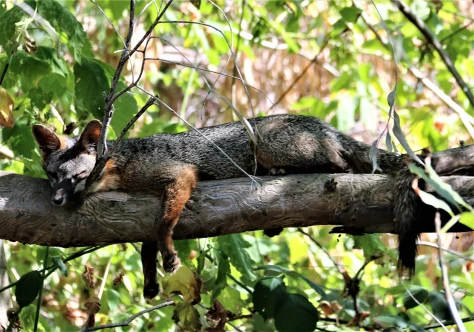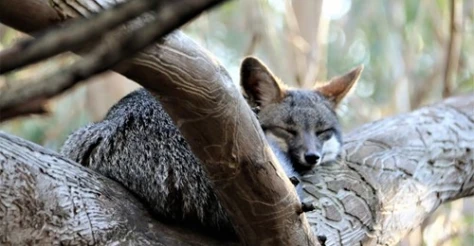How Old is Urocyon cinereoargenteus, the Gray Fox?
by William C. Leikam
President, CEO & Co-founder, Urban Wildlife Research Project

In last month’s issue titled “The Dynamics of the Gray Fox’s Diet”, two people contacted me about the article. One person reminded me. He wrote, “Here on the east coast, we’ve not observed such a clear-cut shift in their diet.” He makes a good point that in different parts of the country the weather conditions and what’s available when it comes to food, will determine much of their behavior. For instance, here in Central California the gray foxes generally give birth during April when the cold has passed, the land is warming and turning green. In places where it’s colder, where snow can still be on the ground in March, the foxes generally give birth later in the year such as in May or even in early June. Given such differences, I’d like to blur the boundaries between the gray fox eating rodents and transitioning over to fruits.
During the month of August, there was nothing of any importance, or any drama that might be worthy of comment. The foxes are simply living the life of a gray fox pair: Napping during the day, and on the hunt at night for between 9 and 12 plus hours. Under such circumstances, I’m going to diverge from focusing solely on our gray fox pair and bring out a few little-known facts about the gray fox.

Older Than….
DNA research has shown that gray foxes are genetically speaking between 8 and 12 million years old *. When I give a live public presentation, I most generally will say 10 million years on the average. So, what does that mean? According to Dr. Benjamin N. Sacks at the University of California, Davis, “Gray foxes are the most evolutionarily basal canid, representing a more ancient lineage than wolves, coyotes, jackals, the South American canids, and all other foxes, including the odd bat-eared foxes of Africa and raccoon dogs of Eurasia.” Your pet dog and we human are youngsters compared with the gray fox.
Since gray foxes cannot interbreed with any other member of the dog family, they cannot hybridize and thus create an animal that genetically shares its genetic code. For instance, a coyote and a wolf can give birth to a hybrid known as a coywolf. When looking at a gray fox you are, at least genetically speaking, looking at a direct and unbroken genetic line that flows back 10 million years or so.
This longevity has given the gray fox numerous unique characteristics. One is its ability to climb trees straight up like a squirrel. People ask, “What in the world do they do up in a tree?” They sometimes use it as a place of refuge especially if there is a predator around like a coyote. They use the tree’s branches as places to ambush birds coming in to roost, or to capture a squirrel for breakfast. They sometimes use that upper story to sleep in. The present gray fox Laimos has a favorite area of a fallen eucalyptus tree where he sleeps. They use the branches to simply play in, especially for the young where they will chase their siblings, wrestle with them and just have fun dashing from limb to limb high in the upper reaches of the trees.
We need your generous donation be it one dollar or 5,000 dollars so that we can begin the collaring project. The collaring project needs $35,000 and here’s the reason why donate to uwrp?
Check out our Facebook page.
You can donate through PayPal or Give Direct, our preferred method for giving. On our website (Urban Wildlife Research Project), check out the short video and go to the donate button on the left of the page. Your donation is tax deductible.
Check out Bill’s interview of July 2, 2020 on Facebook Live https://www.facebook.com/beprovided/live
To find out more about us, search Urban Wildlife Research Project, UWRP, gray foxes, wildlife connection, linkages, corridors and several documentaries and clips on YouTube
If you haven’t had a chance to read some of the articles that have been written about our study of gray fox behavior and our corridor work, click on these links as they will take you to the source: Bill Leikam – The Fox Guy, and Greg Kerekes & URWP
Section III
Gray Fox, Baylands Goals
Within the permit that allows the Urban Wildlife Research Project to conduct its study of the behavior of the gray fox at the Palo Alto Baylands Nature Preserve, the objectives covered area:
- Monitoring of urban gray fox Denning sites in Palo Alto Baylands.
This is being accomplished during the period when the gray foxes use a den site. It is one of the prime locations for gathering most of the behavioral data of the litter and for adults alike.
- Assessment of status and population trends of Baylands urban gray foxes
Since January 2019 a pair of resident gray foxes have claimed territory at the Palo Alto Baylands Nature Preserve.
- Identification of habitat features that promote the presence of urban gray foxes
After considering this and talking with people who know how to restore habitats, we need to assess what kinds of plants, including the Alkaline Salt Bush, would grow best along the edge of the saltwater channel and alongside the marsh. We need to grow a permanent habitat that contains the corridors and plant it as soon as possible. We’ll keep an eye on this as this is a critical link between the southern region of the Baylands and the northern region.
- Assessment of reproductive success and identification of factors that promote successful reproduction
Open up the pinch-point along Matadero Creek by developing thickets that link one area to another, instead of the present “islands”.
- Identification and assessment of possible dispersal travel routes.
Presently there can only be guesses as to dispersal travel routes. We intend to make this important question much more concrete when we attain our collaring/take/capture permit from the Department of Fish & Wildlife.




